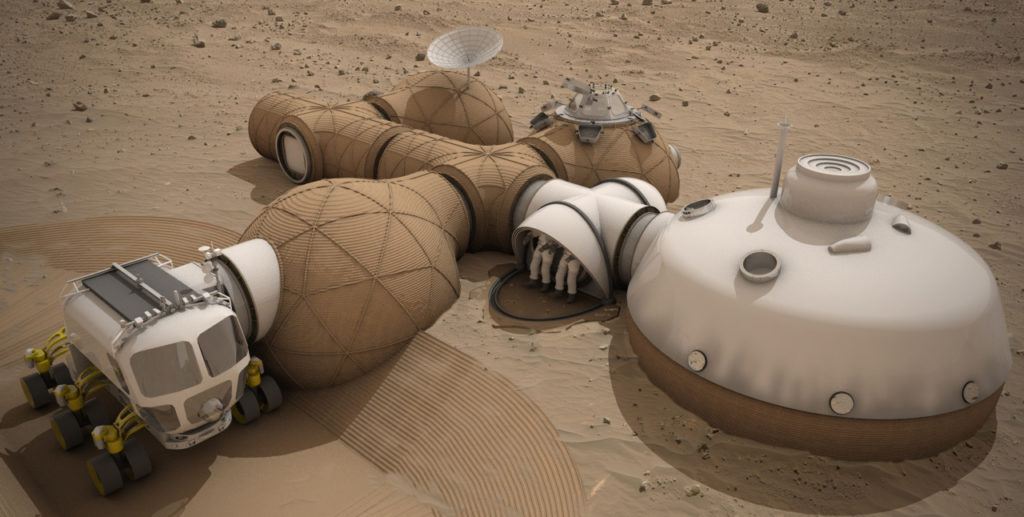University of Central Florida Professor Works with NASA to Further Develop 3D Printing Plans for Mars
 A new space race has emerged as government agencies and private companies around the world strive to be the first to land humans on Mars. While each of these institutions may differ in the details of their plans to reach the Red Planet, one thing that pretty much all of them agree on is the fact that 3D printing is going to play a large role, from the fabrication of the spacecraft to the printing of supplies during the journey to the building of habitable structures upon arrival.
A new space race has emerged as government agencies and private companies around the world strive to be the first to land humans on Mars. While each of these institutions may differ in the details of their plans to reach the Red Planet, one thing that pretty much all of them agree on is the fact that 3D printing is going to play a large role, from the fabrication of the spacecraft to the printing of supplies during the journey to the building of habitable structures upon arrival.
The idea of 3D printing human habitats on Mars makes most people do a double take, but it’s key if we want to spend any significant amount of time there. It’s not feasible to carry construction materials into space, so any structures for living and working will have to be built with the resources that can be found on Mars – i.e., whatever’s in the planet’s soil.
Several ideas have been pitched for technologies that will enable the 3D printing of Mars’ regolith, which consists of soil, dust, rocks, and whatever else is scattered across the planet’s surface. NASA’s citizen science challenges have yielded viable possibilities, and the agency continues to enlist the help of experts such as Dr. Sudipta Seal of the University of Central Florida. Dr. Seal is the interim chair of the university’s Materials Science and Engineering program and the director of the Advanced Materials Processing & Analysis Center and NanoScience Technology Center.
Dr. Seal is working with NASA to research a process called Molten Regolith Electrolysis, which is similar to the technology used to refine metal ores on Earth. The idea is that astronauts would feed Martian soil into a chamber, which would then be heated to nearly 3,000°F, producing oxygen and molten metals via electrolysis. Those metals would then be used to 3D print tools, electronics, and components for ships and buildings.
“It’s essentially using additive-manufacturing techniques to make constructible blocks,” explains Dr. Seal, who will also help NASA determine which form the metals should take to be most suitable for commercial 3D printers. “UCF is collaborating with NASA to understand the science behind it.”
NASA intern Kevin Grossman, a graduate from Dr. Seal’s research group, is also working on the project, which is being funded by a NASA grant. He hopes to see additional projects develop from the collaboration between NASA’s Kennedy Space Center and UCF. The two institutions have been working together for a long time, and Dr. Seal isn’t the only faculty member currently working on the development of construction methods that utilize in situ materials from Mars and elsewhere in space.
Dr. Philip Metzger of UCF’s Florida Space Institute is currently working with Deep Space Industries to develop a way to make Martian soil pliable enough for 3D printing; he and Dan Britt are also working with the company to simulate asteroid regolith that will assist in the development of hardware for asteroid mining. NASA, meanwhile, is sticking to their goal of sending people to Mars in the 2030s, but there’s a lot of work that has to be done before that can feasibly happen. The fact that we’re even approaching the day that humans can live and build on Mars, however, is astonishing, and Dr. Seal is thrilled to be a part of the work.
“Before you go to Mars, you have to plan it out,” he said. “I think this is extremely exciting.”
Discuss in the NASA UCF forum at 3DPB.com.
Subscribe to Our Email Newsletter
Stay up-to-date on all the latest news from the 3D printing industry and receive information and offers from third party vendors.
You May Also Like
$25M to Back Sintavia’s Largest Expansion of Metal 3D Printing Capacity Since 2019
Sintavia, the digital manufacturing company specializing in mission-critical parts for strategic sectors, announced a $25 million investment to increase its production capacity, the largest expansion to its operations since 2019....
Velo3D Initiates Public Offering in a Bid to Strengthen Financial Foundations and Drive Future Growth
Velo3D (NYSE: VLD) has been among a number of publicly traded 3D printing firms that have attempted to weather the current macroeconomic climate. After posting a challenging financial report for 2023,...
Micronics to Offer $2,999 SLS 3D Printer—Is it Real?
A startup called Micronics has recently unveiled a desktop powder bed fusion system priced at a mere $2,999. The team highlights the inclusion of its proprietary slicing software and the...
3DPOD Episode 193: Flow and What’s Possible in 3D Printing with Ricky Wildman, University of Nottingham
Ricky Wildman is working on 3D printing pills, but, as Professor of Multiphase Flow and Physics at Nottingham, he does a whole lot more. His research encompasses the characterization of...

































